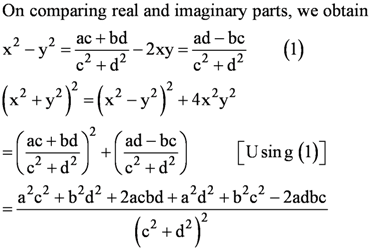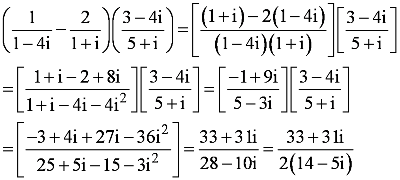Question 4:

Answer



Exams Question Papers General Knowledge Election Directory
Question 3:

Answer


This is the required standard form.
Question 2:
For any two complex numbers z1 and z2, prove that
Re (z1z2) = Re z1 Re z2 – Im z1 Im z2
Answer
Let z1 = x1 + iy1 and z2 = x2 + iy2
∴ z1z2 = (x1 + iy1)(x2 + iy2)
= x1(x2 + iy2) + iy1(x2 + iy2)
= x1x2 +ix1y2 + iy1x2 + i2y1y2
= x1x2 + ix1y2 + iy1x2 + i2y1y2
= x1x2 + ix1y2 + iy1x2 – y1y2 [i2 = −1]
= (x1x2 – y1y2) + i(x1y2 + y1x2)
⇒ Re(z1z2) = x1x2 – y1y2
⇒ Re(z1z2) = Rez1 Rez2 – Imz1 Imz2
Hence, proved.
Question 10:

Answer

This equation can also be written as √2x2 + x + √2 = 0
On comparing this equation with ax2 + bx + c = 0, we obtain
a = √2, b = 1, and c = √2
∴ Discriminant (D) = b2 – 4ac = 12 – 4 × √2 × √2 = 1 – 8 = −7
Therefore, the required solutions are

Question 9:

Answer

The equation can also the written as √2x2 + √2x + 1 = 0
On comparing this equation with ax2 + bx + c = 0, we obtain
a = √2, b = √2, and c = 1
∴ Discriminant (D) = b2 – 4ac = (√2)2 – 4 × (√2) × 1 = 2 – 4√2
Therefore, the required solutions are

Question 8:
Solve the equation √3x2 − √2x + 3√3 = 0
Answer
The given quadratic equation is √3x2 − √2x + 3√3 = 0
On comparing the given equation with ax2 + bx + c = 0, we obtain
a = √3, b = −√2, and c = 3√3
Therefore, the discriminant of the given equation is
D = b2 – 4ac = (−√2)2 – 4(√3) (3√3) = 2 – 36 = −34
Therefore, the required solutions are

Question 6:
Solve the equation x2 – x + 2 = 0
Answer
The given quadratic equation is x2 – x + 2 = 0
On comparing the given equation with ax2 + bx + c = 0, we obtain
a = 1, b = –1, and c = 2
Therefore, the discriminant of the given equation is
D = b2 – 4ac = (–1)2 – 4 × 1 × 2 = 1 – 8 = –7
Therefore, the required solutions are

Question 7:
Solve the equation √2x2 + x + √2 = 0
Answer
The given quadratic equation is √2x2 + x + √2 = 0
On comparing the given equation with ax2 + bx + c = 0, we obtain
a = √2, b = 1, and c = √2
Therefore, the discriminant of the given equation is
D = b2 – 4ac = 12 – 4 × √2 × √2 = 1 – 8 = −7
Therefore, the required solutions are

Question 5:
Solve the equation x2 + 3x + 5 = 0
Answer
The given quadratic equation is x2 + 3x + 5 = 0
On comparing the given equation with ax2 + bx + c = 0, we obtain
a = 1, b = 3, and c = 5
Therefore, the discriminant of the given equation is
D = b2 – 4ac = 32 – 4 × 1 × 5 =9 – 20 = –11
Therefore, the required solutions are

Question 4:
Solve the equation –x2 + x – 2 = 0
Answer
The given quadratic equation is –x2 + x – 2 = 0
On comparing the given equation with ax2 + bx + c = 0, we obtain
a = –1, b = 1, and c = –2
Therefore, the discriminant of the given equation is
D = b2 – 4ac = 12 – 4 × (–1) × (–2) = 1 – 8 = –7
Therefore, the required solutions are

Question 3:
Solve the equation x2 + 3x + 9 = 0
Answer
The given quadratic equation is x2 + 3x + 9 = 0
On comparing the given equation with ax2 + bx + c = 0, we obtain
a = 1, b = 3, and c = 9
Therefore, the discriminant of the given equation is
D = b2 – 4ac = 32 – 4 × 1 × 9 = 9 – 36 = –27
Therefore, the required solutions are

Question 2:
Solve the equation 2x2 + x + 1 = 0
Answer
The given quadratic equation is 2x2 + x + 1 = 0
On comparing the given equation with ax2 + bx + c = 0, we obtain
a = 2, b = 1, and c = 1
Therefore, the discriminant of the given equation is
D = b2 – 4ac = 12 – 4 × 2 × 1 = 1 – 8 = –7
Therefore, the required solutions are

Question 1:
Solve the equation x2 + 3 = 0
Answer
The given quadratic equation is x2 + 3 = 0
On comparing the given equation with ax2 + bx + c = 0, we obtain
a = 1, b = 0, and c = 3
Therefore, the discriminant of the given equation is
D = b2 – 4ac = 02 – 4 × 1 × 3 = –12
Therefore, the required solutions are

Question 8:
Convert the given complex number in polar form: i
Answer
i
Let r cosθ = 0 and r sin θ = 1
On squaring and adding, we obtain
r2 cos2 θ + r2 sin2 θ = 02 + 12
⇒ r2(cos2 θ + sin2 θ) = 1
⇒ r2 = 1
⇒ r = √1 = 1 [Conventionally, r > 0]
∴ cos θ = 0 and sin θ = 1
∴ θ = π/2

This is the required polar form.
Question 7:
Convert the given complex number in polar form: √3 + i
Answer
√3 + i
Let r cos θ =√3 and r sin θ = 1
On squaring and adding, we obtain
r2 cos2 θ + r2 sin2 θ = (√3)2 + 12
⇒ r2(cos2 θ + sin2 θ) = 3 + 1
⇒ r2 = 4
⇒ r = √4 = 2 [Conventionally, r > 0]
∴ 2 cos θ = √3and 2 sin θ = 1
⇒ cos θ = √3/2 and sin θ = 1/2
∴ θ = π/6 [As θ lies in the I quadrant]

This is the required polar form.
Question 6:
Convert the given complex number in polar form : −3
Answer
−3
Let r cos θ = −3 and r sin θ = 0
On squaring and adding, we obtain
r2 cos2 θ + r2 sin2 θ =(−3)2
⇒ r2(cos2 θ + sin2 θ) = 9
⇒ r2 = 9
⇒ r = √9 = 3 [Conventionally, r >0]
∴ 3 cos θ = −3 and 3 sin θ = 0
⇒ cos θ = −1 and sin θ = 0
∴ θ = π
∴ −3 = r cos θ + i r sin θ = 3 cos π + B sin π = 3(cos π + i sin π)
This is the required polar form.
Question 5:
Convert the given complex number in polar form: – 1 – i
Answer
−1 – i
Let r cos θ = −1 and sin θ = −1
On squaring and adding, we obtain
r2 cos2 θ + r2 sin2 θ = (−1)2 + (−1)2
⇒ r2 (cos2 θ + sin2+ θ) = 1 + 1
⇒ r2 = 2
⇒ r = √2 [Conventionally, r > 0]
∴ √2 cos θ = −1 and √2 sin θ = −1

This is the required polar form.
Question 4:
Convert the given complex number in polar form: – 1 + i
Answer
−1 + i
Let r cos θ = −1 and r sin θ = 1
On squaring and adding, we obtain
r2 cos2 θ + r2 sin2 θ = (−1)2 + 12
⇒ r2(cos2 θ + sin2 θ) = 1 + 1
⇒ r2 = 2
⇒r = √2 [Conventionally, r > 0]
∴√2 cos θ = −1 and √2 sin θ = 1

It can be written

This the required polar form .
Question 3:
Convert the given complex number in polar form: 1 – i
Answer
1 – i
Let r cos θ = 1 and r sin θ = –1
On squaring and adding, we obtain
r2 cos2 θ + r2 sin2 θ = 12 + (−1)2
⇒ r2(cos2 θ + sin2 θ) = 1 + 1
⇒ r2 = 2
⇒ r = √2 [Conventionally, r > 0]
∴ √2 cos θ = 1 and √2 sin θ = −1
⇒ cos θ = 1/√2 and sin θ = −1/√2
∴ θ = −π/4 [As θ lies in the IV quadrant]

This is the required polar form.